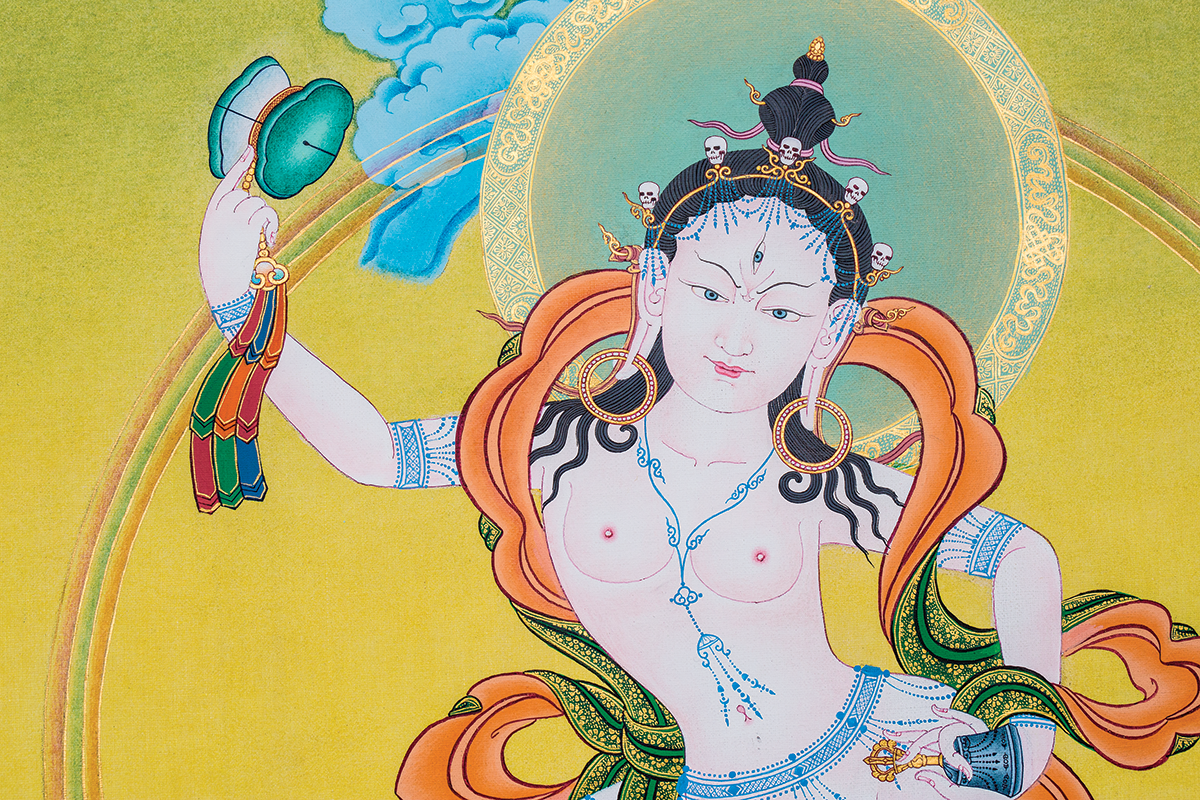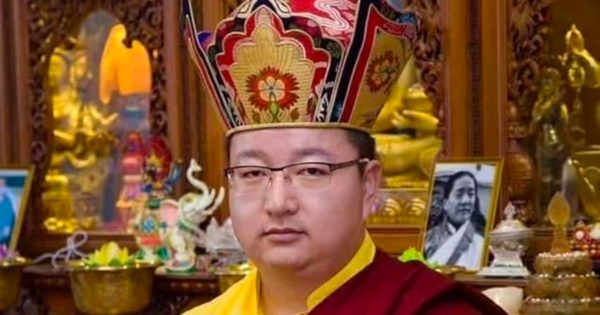Awakening the Sacred Feminine
In Vajrayana Buddhism, dakinis are seen as unbridled and enlightened feminine energy. Lama Tsultrim Allione on how she discovered her own dakini power. Watch Lama Tsultrim Allione in Lion’s Roar’s upcoming free online event, “The Women of Wisdom Summit.”...

When I was eleven, I ran home on the last day of school and tore off my dress, literally popping the buttons off, feeling simultaneously guilty and liberated. I put on an old, torn pair of cutoff jean shorts, a white T-shirt, and blue Keds sneakers, and ran with my sister into the woods behind our gray colonial New Hampshire house. We went to play in the brook burbling down the steep hill over the mossy rocks, through the evergreens and deciduous trees, the water colored rich red-brown by the tannins in the leaves of the maple trees. We would play and catch foot-long white suckerfish with our hands, and then put them back because we didn’t want to kill them.
Sometimes we swam naked at night with friends in the spring-fed lake nearby, surrounded by pine, birch, spruce, and maple trees. I loved the feeling of the water caressing my skin like velvet, with the moon reflecting in the mirror-like lake. My sister and my friend Joanie and I would get on our ponies bareback and urge them into the lake until they were surging up and down with water rushing over our thighs and down the backs of the horses; they were swimming with us as we laughed, clinging onto their backs.
Wildness was so much a part of me; I could never imagine not living a life that didn’t allow for it.
When violent summer thunderstorms blew through, instead of staying in the old wooden house, I would run and dance outside in the rain and thunder, scaring my mother. I liked to eat with my fingers, gnawing on the pork chop bone and gulping down big glasses of milk, in a hurry to get back outside. I loved gnawing on bones. My mother would shake her head, saying in desperation, “Oh, darling, please, please eat with your fork! Heavens alive, I’m raising a barbarian!”
Barbarian, I thought, that sounds great! I imagined women with long hair streaming out behind them, racing their horses over wide plains. I saw streaked sunrises on crisp mornings with no school, waking up outside, and night fires with charred meat and lots of bones to gnaw on. This wildness was so much a part of me; I could never imagine not living a life that didn’t allow for it.
At the time when I first learned about dakinis, I started doing a meditation practice from the Tibetan teacher Sapchu Rinpoche that involved Vajrayogini and the four retinue dakinis, representing the four directions of the mandala.
Since I had only heard about the dakinis a few times in a cursory way, I asked Sapchu Rinpoche, “What is a dakini?”
He replied, “There are many kinds of dakinis, both worldly and wisdom dakinis. The wisdom dakinis are the same level as buddhas; the worldly dakinis can have enlightened aspects but also worldly aspects. Sometimes the dakinis operate as messengers, sometimes as guides, sometimes as protectors. In the dakini practice we develop a way to access the unique and powerful energy of the wisdom dakinis.”
I asked, “What kind of messenger is the dakini?”
Sapchu Rinpoche paused for a moment, and then replied, “The dakini is a messenger of emptiness and also appears in dreams to guide the meditator, and she might appear in real life as a woman with certain wisdom qualities. The dakini is a force of truth: wherever we cling, she cuts; whatever we think we can hide, she reveals.”
 Dancing Vajravarahi (Dorje Pagmo); Nepal, 14th century; Courtesy of LACMA
Dancing Vajravarahi (Dorje Pagmo); Nepal, 14th century; Courtesy of LACMAAs I began to practice the dakini mandala, I began to sense a power within myself that I had not ever allowed myself to feel. The idea of an enlightened, sacred feminine energy that was also naked, dancing, and fierce was something I had never experienced, and it touched me deeply. I couldn’t put into words the effect it had on me, but it was something significant and new.
The fierce dancing dakinis embody and activate the powerful and transformative energy of the feminine. When you think about it, we really don’t have that kind of image of spiritual enlightenment in our world. We have a figure like the Holy Virgin Mother, who is peaceful and nonthreatening, but we don’t have many reflections of female divinity that are active, dancing, fierce, free, and wild.
By activating the dakini power within us, we will have an inner resource that should never be underestimated. What we’re really doing is taking a part of the psyche that’s been relegated to the unconscious—the fierce, powerful feminine who has become repressed—and we are bringing that energy forward and exploring that energy’s potential for enlightenment.
The dakinis tend to push us through blockages. They appear during challenging, crucial moments when we might be stymied in our lives; perhaps we don’t know what to do next and we are in transition. Maybe an obstacle has arisen and we can’t figure out how to get around or get through—then the dakinis will guide us. If in some way we’re stuck, the dakinis will appear and open the way, push us through; sometimes the energy needs to be forceful, and that’s when the wrathful manifestation of a dakini appears.
Dakinis break open the shell of those conventional structures into an embrace of life in which all experience is seen as sacred.
Often the dreams of the dakinis will come at dawn, or they will appear in cemeteries at sunset or dawn—cemeteries being very important symbols of the liminal space between worlds, the twilight hour, which is in fact why the language of the dakinis is a symbolic one called the twilight language. As I wrote in my book Women of Wisdom: “Twilight is the time between waking and sleeping, the conscious and the unconscious. It is a time when the switchover takes place, so there could be a gap, a crack in the wall of the ever-protective ego structure where significant communication from something beyond could take place. At dawn we are still beyond the limiting forces of the conscious mind, yet the heavy veil of deep sleep has lifted. We often find the dakini at these transitional points, when we are open to the ‘twilight’ language.”
Another important aspect of the dakini’s feminine energy is how they cut through notions of pure and impure, clean and unclean, what you should do and shouldn’t do. They break open the shell of those conventional structures into an embrace of life in which all experience is seen as sacred.
If we look at the early stories of tantric Buddhism, there are all kinds of examples of situations where people are presented with something they perceive to be impure, and then a dakini appears and cuts through that and says, “If you’re seeing this as pure or impure, you’re clearly not understanding the point.”
There’s a story of the monk Abhayakaragupta, an accomplished Hindu scholar. He has not yet become a Buddhist when a low-caste woman appears at his door, asking him to have sex. Horrified, he tells her he can’t touch her, never mind having sex, or he will be defiled. He chases her away, afraid someone will see him talking to her and he will be criticized for having contact with a low-caste woman. Before she leaves, she tells him to go to a certain place to receive tantric Buddhist initiation, but he doesn’t follow her suggestion.
Then after he becomes a Buddhist monk, a young girl comes to him and offers him raw meat. He is disgusted by this offer and refuses. Sometime later, when he is already in his tantric apprenticeship, he has a third encounter. His guru’s female attendant, who usually brings him his water, comes to his room and offers to do a tantric feast with him. When he turns her down, she orders him to do so, giving him another chance. But he is oblivious of who she really is and refuses again.
Then she chastises him and tells him that since he has failed to recognize Vajrayogini three times, he has missed his chance to attain enlightenment during his lifetime. The wisdom dakini Vajrayogini sent her emanations to him three times, but, caught in ideas of pure and impure, he failed to recognize her. Her tests challenged his preconceptions and prejudices to recognize the dakini, but he failed. He was worshipping the divine feminine in his meditations, but did not recognize and honor her human manifestation.
You can see here how, although this happened many, many years ago in India, it’s not that different in our lives now. We’re always encountering situations in which we’re liking or disliking things. We like or dislike foods. We like or dislike places. We like or dislike people. We think something is pure or something is impure; something is dirty or something is clean. These beliefs of duality are all things that the dakinis break through, even those golden rules of celibacy and vegetarianism practiced by the monks. They open and embrace all phenomena, recognizing all phenomena as “one taste,” as equal.
Practicing Tibetan Buddhism more deeply, I came to realize that the dakinis are the undomesticated female energies—spiritual and erotic, ecstatic and wise, playful and profound, fierce and peaceful—that are beyond the grasp of the conceptional mind. There is a place for our whole feminine being, in all its guises, to be present.
Adapted from Wisdom Rising: A Journey into the Mandala of the Empowered Feminine, by Lama Tsultrim Allione. Reprinted with permission from Enliven Books.

Lama Tsultrim Allione is the founder of the Tara Mandala retreat center in Pagosa Springs, Colorado, and author of Women of Wisdom and Feeding Your Demons. In 1970 she became one of the first American women to be ordained in the Tibetan Buddhist tradition. She was a 2009 recipient of the Outstanding Women in Buddhism Award.

 Konoly
Konoly 
































